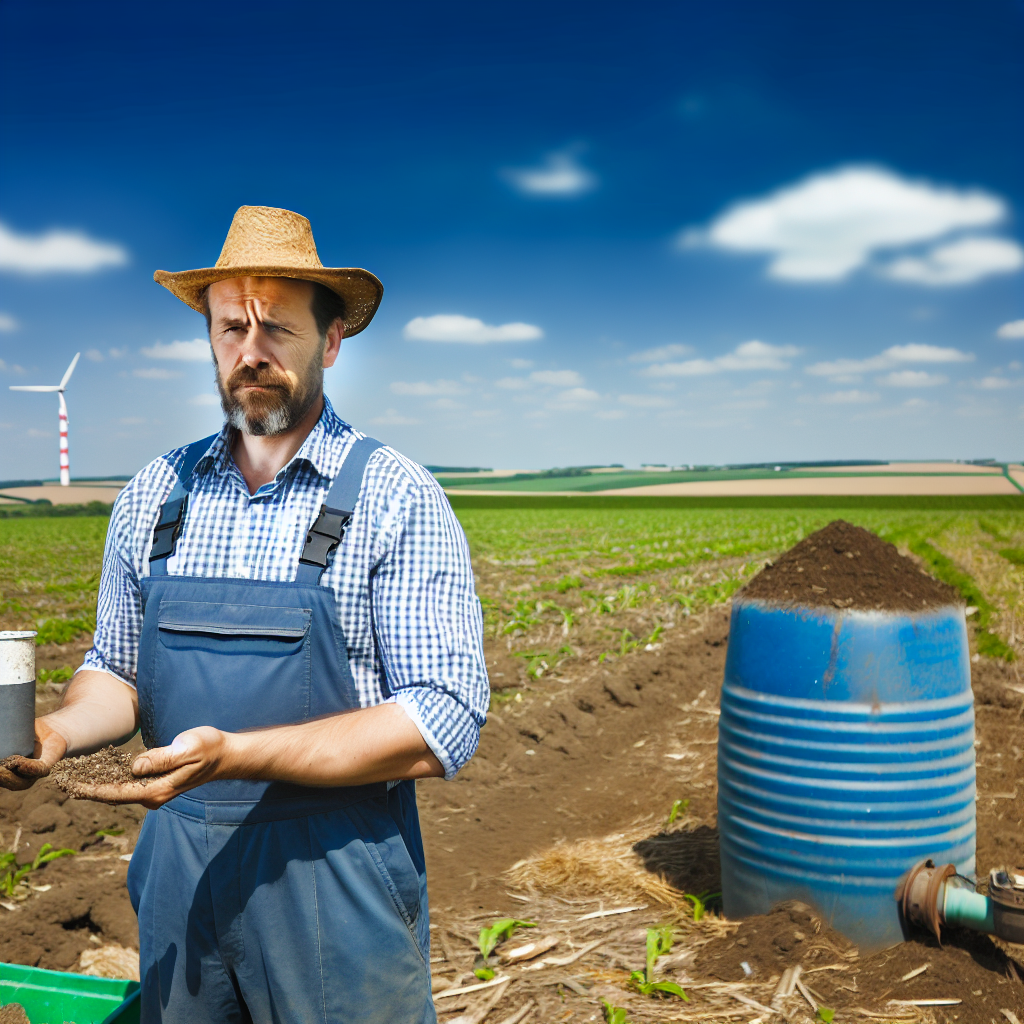Introduction to Resilient Farming and Its Importance
Resilient farming is crucial for adapting to climate change.
This approach enhances agricultural sustainability and productivity.
Farmers face numerous challenges today, including extreme weather.
Resiliency enables them to cope with unpredictable conditions.
Furthermore, it reduces the dependence on chemical inputs.
Defining Resilient Farming
Resilient farming focuses on creating robust agricultural systems.
These systems thrive under fluctuating environmental conditions.
Additionally, they promote ecological balance within ecosystems.
Soil health and biodiversity are central to this approach.
The Role of Climate Change
Climate change significantly impacts traditional farming practices.
Farmers must adapt to rising temperatures and erratic rainfall.
Resilient farming provides strategies to mitigate these effects.
These strategies enhance the long-term viability of farms.
Benefits of Resilient Farming
Enhanced soil health results from diversified crop rotations.
This method improves nutrient cycling in the ecosystem.
Transform Your Agribusiness
Unlock your farm's potential with expert advice tailored to your needs. Get actionable steps that drive real results.
Get StartedMoreover, resilient farms can better withstand pests and diseases.
Diverse planting increases yields and stabilizes income.
Economic Stability
Economic resilience is vital for farmers facing market fluctuations.
By diversifying crops, farmers reduce financial risk.
They can sell different products in various markets.
Community Engagement and Support
Resilient farming promotes collaboration within local communities.
Farmers often share resources and knowledge to strengthen networks.
This support system enhances local food security and resilience.
Understanding the Key Principles of Resilient Agriculture
Diversification of Crops
Diversification boosts farm resilience to environmental changes.
It reduces dependency on a single crop.
This strategy mitigates risks associated with pests and diseases.
Moreover, it enhances soil health and biodiversity.
Soil Health Management
Healthy soil is vital for resilient farming.
It sustains root systems and improves water retention.
Practices such as cover cropping and reduced tillage enhance soil biology.
Furthermore, organic amendments can increase nutrient availability.
Integrated Pest Management
Integrated pest management focuses on long-term pest control strategies.
This approach combines biological, cultural, and chemical tactics.
It aims to minimize pesticide use, benefiting both farms and the environment.
By monitoring pest populations, farmers can make informed decisions.
Water Management Techniques
Effective water management increases agricultural resilience.
Techniques such as drip irrigation conserve water resources.
Additionally, rainwater harvesting can provide supplementary supply.
Soil moisture monitoring helps optimize irrigation practices.
Showcase Your Farming Business
Publish your professional farming services profile on our blog for a one-time fee of $200 and reach a dedicated audience of farmers and agribusiness owners.
Publish Your ProfileClimate Adaptation Strategies
Adapting to climate change is critical for future farming.
Cultivating drought-resistant crops enhances resilience against dry conditions.
Farmers should also adjust planting dates based on climate patterns.
Investing in weather forecasting tools enables proactive decision-making.
Community and Knowledge Sharing
Building a network among farmers strengthens resilience.
Sharing knowledge and experiences fosters adaptation strategies.
Collaborative farming initiatives can pool resources and insights.
This community approach empowers farmers to face common challenges.
Read: Discover Harrell’s in Charlotte: Your Trusted Partner for Fertilizer Solutions
The Role of Climate Change in Shaping Farming Practices
The Impact of Temperature Changes
Climate change leads to rising global temperatures.
These increases affect crop yields and livestock health.
Farmers must adapt to shifting climate patterns.
Transitioning to heat-resistant crop varieties becomes essential.
Moreover, improved livestock breeds can withstand heat stress.
The Influence of Weather Patterns
Changing weather patterns disrupt traditional farming schedules.
For instance, unpredictable rainfall affects planting and harvesting.
Farmers are increasingly turning to climate forecasting tools.
These tools help them plan for droughts or floods.
In addition, water management techniques are crucial for resilience.
Soil Degradation and Conservation
Climate change exacerbates soil degradation issues.
In response, sustainable soil management practices are vital.
Crop rotation helps maintain soil health and fertility.
Cover cropping reduces erosion while improving soil structure.
Furthermore, conservation tillage techniques enhance soil moisture retention.
Economic Considerations for Farmers
Climate change poses economic challenges for farmers.
Crop failures can lead to significant financial losses.
Insurance schemes offer some protection against these losses.
However, investing in resilient farming practices is crucial.
This shift can help secure long-term agricultural viability.
The Role of Technology in Adaptation
Advancements in technology enable effective adaptation strategies.
Precision agriculture enhances resource efficiency and productivity.
Drones and sensors monitor crop health and soil conditions.
Data analytics support informed decision-making on the farm.
Additionally, genetically modified organisms (GMOs) can improve resilience.
Explore Further: Why Regenerative Agriculture Is the Future of Farming in America
Examples of Resilient Farming Techniques
Agroforestry
Agroforestry integrates trees and shrubs into crop and livestock systems.
This approach enhances biodiversity and improves soil health.
Moreover, it provides additional income through timber or fruit production.
Agroforestry systems can also help mitigate climate change effects.
Farmers like Emily Johnson have successfully adopted agroforestry techniques.
Showcase Your Farming Business
Publish your professional farming services profile on our blog for a one-time fee of $200 and reach a dedicated audience of farmers and agribusiness owners.
Publish Your ProfileThey report increased yields and environmental benefits.
Crop Rotation
Crop rotation involves alternating the types of crops grown in a specific area.
This method improves soil fertility and interrupts pest cycles.
For instance, rotating legumes with cereals enriches the soil with nitrogen.
Farmers can enhance their resilience against disease outbreaks through crop rotation.
Case studies show that effective crop rotations can yield better harvests.
Cover Cropping
Cover cropping uses specific plants to cover the soil during off-seasons.
This practice protects soil from erosion and reduces nutrient loss.
Additionally, cover crops can enhance soil organic matter over time.
Farmers such as Mark Thompson have reported improved soil structures.
These improvements lead to better water retention and crop productivity.
No-Till Farming
No-till farming minimizes soil disturbance and maintains its structure.
This method helps prevent erosion and preserves moisture levels.
As a result, it can boost organic matter and enhance soil health over time.
Farmers implementing no-till practices often experience reduced input costs.
Real-world examples indicate significant improvements in yields and ecological health.
Integrated Pest Management
Integrated Pest Management (IPM) combines biological, cultural, and chemical tactics.
This method focuses on sustainable pest control strategies.
Farmers utilizing IPM can reduce dependency on chemical pesticides.
Furthermore, IPM enhances biodiversity and supports ecosystem health.
Studies show that IPM effectively manages pest populations while maintaining yields.
Explore Further: How Small Farms Are Thriving in the Era of Agritech
The Economic Benefits of Transitioning to Resilient Farming Systems
Understanding Resilient Farming
Resilient farming adapts to challenges effectively.
This system embraces diversity in crops and practices.
Farmers implement strategies to mitigate climate risks.
They focus on soil health, water conservation, and biodiversity.
As a result, they prepare for unpredictable climatic events.
Cost Savings Through Efficiency
Transitioning to resilient systems often reduces costs.
Farmers save on inputs like water, fertilizers, and pesticides.
For instance, crop rotation improves soil fertility naturally.
Consequently, farmers spend less money on chemical inputs.
This lowers overall production costs, maximizing profits.
Market Opportunities and Demand
Consumers increasingly seek sustainably produced foods.
Resilient farms can tap into these growing markets.
They often receive premium prices for organic and local products.
Farmers can develop direct relationships with consumers.
This enhances market access and loyalty from customers.
Enhancing Community Resilience
Resilient farming contributes positively to local economies.
It creates jobs in agricultural sectors and related industries.
Successful farms support community resilience through food security.
Showcase Your Farming Business
Publish your professional farming services profile on our blog for a one-time fee of $200 and reach a dedicated audience of farmers and agribusiness owners.
Publish Your ProfileThey also engage in educational initiatives for local farmers.
Long-Term Value and Sustainability
Investing in resilient farming yields long-term benefits.
Healthy ecosystems provide ongoing agricultural productivity.
Additionally, these practices help combat climate change impacts.
Farmers improve the resilience of their businesses over time.
This sustainable approach ensures food availability for future generations.
Explore Further: The Smart Way to Revolutionize Your Farming Operations
Challenges Farmers Face in Implementing Resilient Practices
Financial Constraints
Farmers often encounter financial constraints when shifting to resilient practices.
The upfront costs for new technologies and methods can be substantial.
Additionally, many farmers operate on tight margins, limiting their investment potential.
Over time, however, these investments can lead to savings and increased yields.
Lack of Knowledge and Training
Another obstacle is the lack of knowledge about resilient farming techniques.
Farmers may not be aware of the benefits of crop rotation or cover cropping.
Furthermore, training opportunities can be limited in rural areas.
Collaborative workshops and local expertise can enhance understanding.
Resistance to Change
Many farmers show resistance to changing long-established practices.
This resistance often stems from a fear of unknown outcomes.
Moreover, traditional practices can provide a sense of stability.
Gradual implementation and demonstration projects can help ease this transition.
Market Pressures
Market pressures can hinder the adoption of resilient farming methods.
Farmers often feel compelled to prioritize short-term profits over sustainability.
Additionally, consumer demand for uniform products discourages diversity in crops.
As consumers become more educated, market preferences may shift toward resilience.
Climate Uncertainty
Farmers regularly face challenges from unpredictable climate conditions.
Extreme weather events can disrupt planning and crop yields.
This uncertainty creates anxiety about the effectiveness of resilient practices.
Adaptive management strategies can help farmers cope with these changes.
See Related Content: The Ultimate Guide to Modern Farming Techniques

Government Policies and Support for Resilient Farming Initiatives
Overview of Current Policies
Government policies play a crucial role in promoting resilient farming.
Recently, many countries emphasized sustainable agricultural practices.
These initiatives aim to mitigate the impacts of climate change.
Financial Incentives
Financial support is essential for farmers adopting resilient practices.
Government programs provide grants and loans for sustainable projects.
Furthermore, tax incentives encourage businesses to invest in eco-friendly technologies.
Research and Development Funding
Investing in research enhances farming resilience.
Public funding supports innovative agricultural technologies.
Collaboration with universities accelerates the development of sustainable methods.
Education and Training Programs
Education remains vital for successful implementation of new practices.
Government agencies organize workshops and training sessions for farmers.
These programs teach effective strategies for sustainable agriculture.
Showcase Your Farming Business
Publish your professional farming services profile on our blog for a one-time fee of $200 and reach a dedicated audience of farmers and agribusiness owners.
Publish Your ProfileRegulatory Frameworks
A clear regulatory framework establishes guidelines for sustainable farming.
Compliance with environmental regulations ensures the protection of natural resources.
Thus, better regulations foster a culture of resilience in agriculture.
Public-Private Partnerships
Partnerships between government and private entities catalyze innovation.
These collaborations can streamline the adoption of advanced practices.
Moreover, they facilitate resource sharing among stakeholders.
Case Studies of Successful Initiatives
Examining successful initiatives provides valuable insights.
For instance, the “Green Growth” initiative in Oregon improved water management.
Similarly, Florida’s “Resilient Agriculture” framework helped combat climate-related risks.
Future Outlook: Innovations in Technology Supporting Resilient Agriculture
Precision Agriculture
Precision agriculture utilizes data analytics for improved crop management.
This technology enhances decision-making for farmers.
It allows for targeted applications of water, fertilizers, and pesticides.
As a result, it boosts yields while minimizing environmental impacts.
Biotechnology Advances
Biotechnology continues to revolutionize resilient farming practices.
Genetic modification enhances crop resistance to diseases and pests.
Additionally, it allows crops to thrive in extreme weather conditions.
This innovation leads to increased food security globally.
Agricultural Robotics
Robotics play a key role in modern agricultural practices.
Automated machinery improves efficiency in planting and harvesting.
Robots reduce labor costs and enhance productivity on farms.
Moreover, they help in precision applications, such as weeding and spraying.
Sustainable Practices through Technology
Innovative technologies promote sustainable farming methods.
Vertical farming and hydroponics exemplify this trend.
These techniques use less land and water compared to traditional farming.
Consequently, they help mitigate climate change effects.
Data-Driven Decision Making
Access to real-time data empowers farmers to make informed choices.
Farm management software integrates various data sources.
This approach enhances operational efficiency and productivity.
Farmers can track everything from crop health to market trends.
Collaboration and Knowledge Sharing
Collaboration among farmers, researchers, and companies fosters innovation.
Knowledge sharing leads to improved farming techniques.
Moreover, partnerships enhance access to new technologies and practices.
Such collaboration supports resilience against climate challenges.
The Vision for a Sustainable and Resilient Farming Future
Embracing Change in Agricultural Practices
The future of farming hinges on embracing new practices.
Farmers must adopt methods that enhance resilience.
For example, crop rotation improves soil health.
Additionally, integrating livestock can diversify farm production.
Investing in Technology and Innovation
Technology plays a crucial role in modern farming.
Farmers should invest in precision agriculture techniques.
These techniques help optimize resources and yields.
Showcase Your Farming Business
Publish your professional farming services profile on our blog for a one-time fee of $200 and reach a dedicated audience of farmers and agribusiness owners.
Publish Your ProfileMoreover, the use of drones and sensors can monitor crop health.
Building Stronger Community Connections
A resilient farming future depends on community ties.
Farmers can benefit from local networks and support.
Create partnerships with local businesses for better distribution.
Furthermore, educational initiatives can promote sustainable practices.
Fostering Environmental Stewardship
Environmental stewardship is key for sustainability.
Farmers should practice conservation agriculture techniques.
This minimizes soil erosion and improves water retention.
Additionally, cover crops can enhance biodiversity on farms.
Encouraging Policy and Regulatory Support
Supportive policies are essential for resilient farming.
Governments should promote subsidies for sustainable practices.
Agricultural research funding can spur innovation.
Moreover, improved land-use policies can benefit farmers directly.
Preparing for an Uncertain Future
Resilient farming prepares us for future uncertainties.
Climate change poses significant challenges for agriculture.
Farmers must adapt to changing weather patterns.
By enhancing insect resistance and drought tolerance, crops can thrive.
Collaborating for a Better Tomorrow
Collaboration among stakeholders enhances resilience.
Farmers, researchers, and policymakers must work together.
This collective effort fosters innovative solutions to challenges.
By sharing knowledge and resources, we strengthen our systems.
Additional Resources
Statements of Support for the Agriculture Resilience Act | U.S. …




